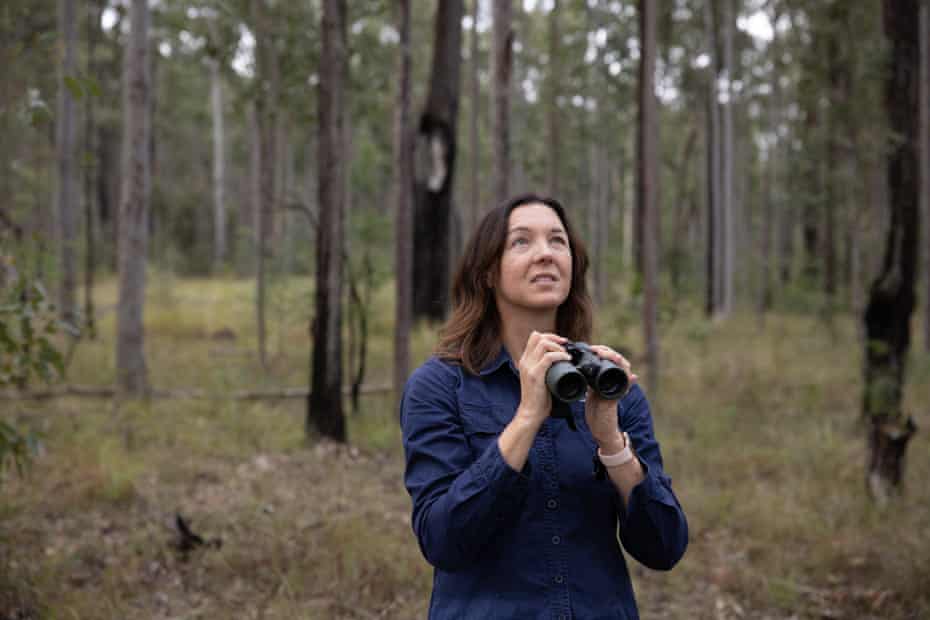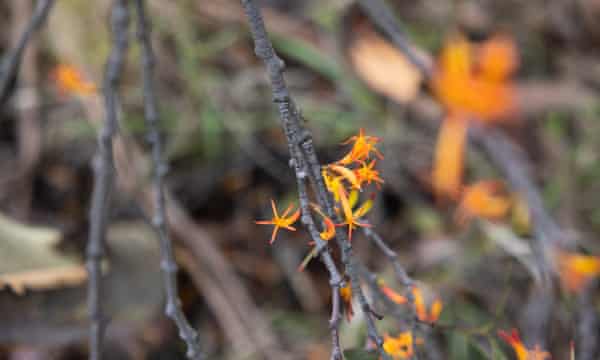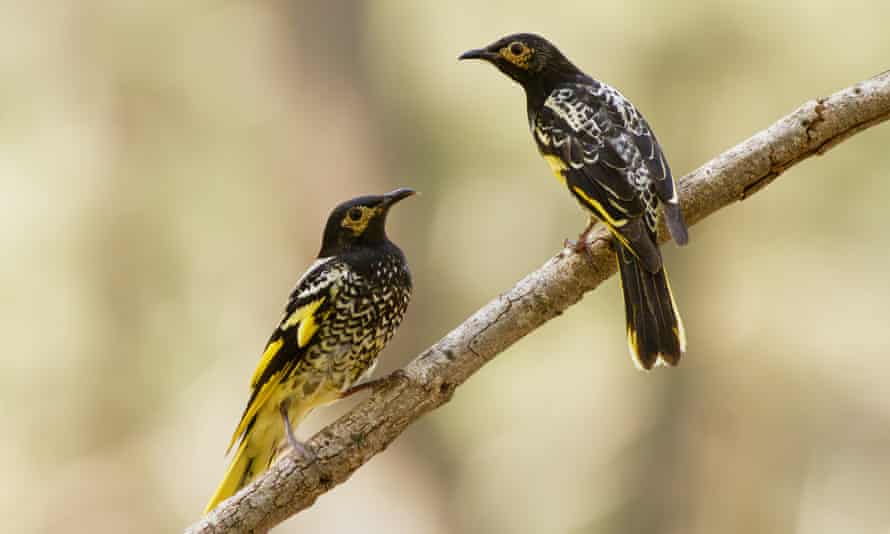‘Love song’ lost: the fight to stop Australia’s regent honeyeater from dying out
At least 1,000 long-flowered mistletoe seeds, a key breeding source for the species, will be planted into host trees in the lower Hunter Valley

So few of Australia’s regent honeyeaters remain, its distinctive mating song is slowly being lost to its dwindling population.
Its staccato burst of pips and squeaks, a “funny sort of call”, was passed down to young males from “uncles” when honeyeaters, a nomadic species, still travelled in flocks.
“It’s a very sad thing to think the species can become so endangered they don’t have those adult teachers around,” BirdLife Australia project officer Kristy Peters said.
“Lone males often can’t find females to breed … [so] when the young leave the nest, they would come across other regent honeyeaters and learn songs from other adult males.
“But with far fewer birds around to learn from, they’re mimicking the calls of other species they’re co-existing with, like red wattlebirds and noisy friarbirds. The female birds don’t respond well to these calls which leads to lower nest success … and the birds aren’t being taught to leave the nest and join the world.”

Fewer than 350 of the critically endangered species remain despite its high distribution, spanning from south-east Queensland down to Victoria. But a project to plant mistletoe to regenerate one of their key New South Wales nesting sites, may prevent the species from dying out in the coming decade.
Working with the Mindaribba Local Aboriginal Land Council and local landcare groups, BirdLife Australia is aiming to plant at least 1,000 long-flowered mistletoe seeds, a key breeding source for the species, into host trees in the Kurri Kurri and Cessnock woodlands, in the hope regent honeyeaters will return in larger numbers to breed and flock once more.
The honeyeater has been battered by historical and ongoing habitat destruction and fragmentation, as well as the loss of their “love song” leading to a drop in reproduction rates.
The project builds on a similar trial which took place in the City of Melbourne, that planted 800 mistletoe seeds into urban plane trees to bring food and shelter for fruit and nectar eating birds and possums.
“We thought, how can we do that to bring back regent honeyeaters where their native resources have been lost?” Peters said.
“So we did an initial trial in 2019 and had some success with germination. At the time it was a novel procedure – it wasn’t something widely done in bush regeneration.
“But we got in there and planted as much mistletoe as we could to the habitat that had been lost through bushfires.”
There are almost 100 species of mistletoe in Australia, all native, with leaves resembling eucalyptus. Its plants, once attached to host trees, bring nectar, fruit and a dense network of branches for birds and animals to nest in.
“Mistletoe often provides blossoming resources right across the landscape, because it’s basically a parasite,” Peters said.
“It can get nutrients and water by attaching to the host, and flower throughout the year if it isn’t subject to drought.”

This summer, a team of conservationists, traditional owners from the Mindaribba Local Aboriginal Land Council and arborists will return to the Hunter Valley, one of the most “important contemporary breeding areas” for the species, to pick and plant the food and nesting source.
The valley has been subject to severe wildfires since 2015, which have “knocked off” a lot of the already seasonal and cyclical resources – the eucalypts, for instance, won’t flower every year.
“Consistent fire damage has impacted the site and after the Black Summer bushfires having burnt other contemporary breeding sites … there is a very urgent need to restore … the woodlands,” Peters said.
“There are only three other key breeding sites in New South Wales: Capertee, Widden and Burragorang Valley, rich in white box, yellow box and iron bark woodlands.
“We’re trying to kickstart the process because the piece of bush is really special – regent honeyeaters come back every three or four years when the right conditions hit, and the ironbark and mistletoe and eucalypts is flowering.”
The natural processes for mistletoe to return to the forests, spread by birds like the mistletoe bird, would take too long to allow the honeyeater to repopulate. But by blitz planting the seeds, mistletoe could function as a habitat within three to four years.
The program, which secured $50,000 in funding from Landcare Led Bushfire Recovery Grants, is training volunteers to source fruit from mistletoe clumps and prepare for arborists to plant them into the burnt areas.
In the next phase, to kick off next month when the mistletoe fruits, arborists will climb up into the trees to feed the canopies, which will eventually grow to produce their own flowers and fruit.
“Volunteers will help us plant the seeds low down as we walk around the forest, which will eventually attract mistletoe birds back to the area, but that wouldn’t help our regent honeyeaters as they only use mistletoe clumps that are high in the trees,” Peters said.
“So, to get the seeds up into the canopy, we employ professional arborists to hoist the seeds up high to places where the birds will use them.”
Next March, traditional owners will hold a two-way knowledge sharing workshop with local landholders, government staff and environmental volunteers, building on their collective knowledge of country, ecology, bush regeneration and land management.
“The birds don’t eat fruit, but they love the blossom and nectar from the tubular flowers with their honeyeater bill … native mistletoe is really abundant, but, when it fruits, it doesn’t have a long shelf life and needs to be planted soon afterwards,” Peters said.
“I’m hoping the process will teach other people how to handle the fruit so they can do it themselves, wipe the seeds on the underside of a branch and learn the tricks involved … the native mistletoe species is important to a whole range of birds and animals.
“A gardener at home can, in the right circumstances, work out what host trees they can plant it into and create a super sharing ecosystem, producing fruit and flowers in a shorter time to tree planting.”
Last month, Peters and her team released an initial 58 honeyeaters into the Kurri Kurri and Cessnock woodlands as the first of the mistletoe began to flower.
Using radio transmitters, the team have been able to watch the birds pair up, build nests and teach honeyeaters the wild calls played to them in aviaries.
“Hopefully chicks will be born knowing the area, and in another few years we’ll have a lot more habitat restored, and we’ll see them come back when the right conditions are there,” Peters said.
“I’m so excited and thrilled they’re doing what they’re supposed to.”